Automated anterior lamellar keratoplasty combines dermoid excision, fibrin glue
It is advisable to have a donor cornea in the operating room because the lesion can involve the cornea at varying depths.
 |
Limbal dermoids are most frequently found at the inferior temporal quadrant of the eye and are benign congenital tumors that contain choristomatous tissue (tissue not normally found at that location).

These aberrant tissues of ectodermal and mesodermal origin can include hair follicles (Figure 1), sweat and sebaceous glands, ectopic lacrimal gland, skin, fat, muscle, cartilage, bone, vascular structures and even brain. They are usually unilateral, and malignant degeneration is extremely rare. They may be associated with other congenital ocular and systemic abnormalities such as oculo-auriculo-vertebral dysplasia (Goldenhar’s syndrome), Duane’s syndrome, lacrimal stenosis and coloboma of the upper eyelid.
Symptoms include decreased vision, foreign body sensation, enlarging mass or cosmetic disfigurement. They are usually dome-shaped and appear fleshy with fine superficial vascularization (Figure 1). The surface of the dermoid may be keratinized, with visible cilia. Surgical excision may be performed for cosmetic reasons — enlarging mass that the patient wants removed — or if the mass involves the central cornea, resulting in corneal astigmatism and decreased vision. The depth of involvement can vary, and hence, preoperative ultrasound biomicroscopy would often help in proper visualization of the lesion and help in the surgical planning. It is important to have a donor cornea available in the operating room when surgical excision of the lesion is planned.
In this article, I describe a new surgical technique of using automated anterior lamellar keratoplasty combined with dermoid excision and the use of fibrin glue.
Surgical technique
General anesthesia is preferred because most patients are young. First, the dermoid straddling the limbus is measured using a Castroviejo surgical caliper (Figures 1 and 2).
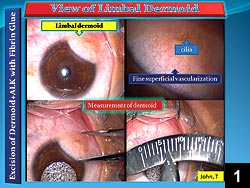 Intraoperative, low-power view of a limbal dermoid located in the inferior temporal quadrant of the limbus and extending into the peripheral cornea (upper left); High-power view of limbal dermoid showing fine, superficial vascularization and cilia (box-arrows; upper right); Vertical measurement of the limbal dermoid using Castroviejo calipers (lower left); The limbal dermoid measures 6.75 mm in vertical length (lower right). | 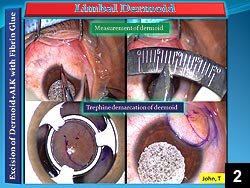 Horizontal measurement of the limbal dermoid using Castroviejo calipers measures 7.75 mm (upper row); A disposable Hanna trephine is used to partially trephine the outer limits of the dermoid (lower row). Images: John T |
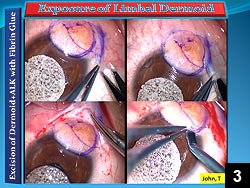 Conjunctival exposure of the limbal dermoid (upper row and lower left); Corneal lamellar dissection of the limbal dermoid (lower right). | 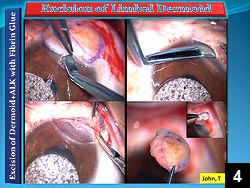 Lamellar dissection of the limbal dermoid (upper row and lower left); Fully excised limbal dermoid (lower right). |
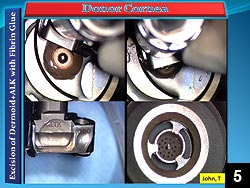 Donor cornea is encased within the Moria automated anterior lamellar keratoplasty system and an automated Moria CB-microkeratome is used to prepare the donor lamellar graft (upper row); Excised lamellar graft is seen within the Moria automated anterior lamellar keratoplasty microkeratome head (lower left); Hanna disposable trephine is used to trephine the donor lamellar graft to the required diameter (lower right). | 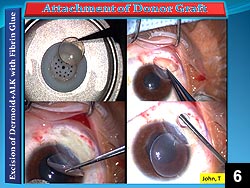 Donor corneal lamellar graft is placed on the ocular surface in the region where the dermoid was excised (upper row); Application of the fibrin glue, component 1, to the recipient’s ocular surface where the dermoid was surgically excised (lower row). |
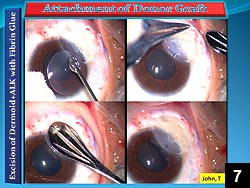 Application of the fibrin glue, component 2, to the donor lamellar graft (upper left); Attachment of the donor lamellar graft to the corneal and scleral surface of the recipient ocular surface (upper right and lower row). | 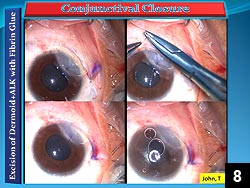 Conjunctival closure (upper row and lower left); Bandage contact lens is placed on the ocular surface at the conclusion of the surgical procedure (lower right). |
Measurements are taken in the vertical and horizontal axis of the lesion. Next, the lesion is well-demarcated using a Hanna disposable trephine (Moria), and partial trephination is carried out (Figure 2). The conjunctiva and Tenon’s are dissected using 0.12 forceps and Westcott scissors to fully expose the limbal dermoid (Figure 3). Hemostasis is achieved by using a disposable cautery. Maintaining proper plane of dissection is essential throughout the procedure. By blunt and sharp dissection, the limbal dermoid is fully excised (Figure 4).
Donor corneal preparation
The donor cornea is mounted within a Moria automated anterior lamellar keratoplasty system, and the artificial anterior chamber is pressurized (Figure 5). A Moria CB microkeratome is used to excise a lamellar disc of appropriate thickness to match the area of tissue excision on the recipient ocular surface. The excised lamellar disc is then placed in the well of a Hanna trephine, and using the same trephine that was used to demarcate the lesion, trephination of the donor lamellar graft tissue is carried out.
Attachment of the donor corneal disc to recipient limbal region: Using sterile balanced salt solution, the stromal surface of the donor corneal disc and the ocular surface of the patient’s limbal area are thoroughly rinsed to remove any debris that may otherwise get trapped in the donor-recipient interface. The donor corneal disc is then attached with a single 10-0 nylon suture and the disc is flipped over to expose the stromal surface of the donor corneal disc (Figure 6, on page 44). Component 1 of the fibrin glue is applied to the limbal region of the patient’s ocular surface where the dermoid was surgically excised. Next, component 2 of the fibrin glue is applied to the stromal surface of the donor corneal disc, and it is then flipped back in place to cover the area of excised dermoid lesion (Figure 7). Uniform pressure is applied to the surface of the donor corneal disc to facilitate optimal adhesion of the donor corneal disc to the recipient bed. The conjunctiva is then approximated at the limbus with two interrupted 10-0 Vicryl sutures. A bandage soft contact lens is the applied to the ocular surface (Figure 8).
Surgical pearls and tips
- Seal the rim of the wound with fibrin glue to prevent epithelial ingrowth.
- Because the dermoid can involve the cornea at varying depths, it is advisable to have a donor cornea in the operating room.
Treatment
Preoperatively, Iquix (levofloxacin 1.5%, Vistakon) is used. Postoperatively, Pred Forte 1% (prednisolone acetate 1%, Allergan) and levofloxacin 1.5% are used four times a day. Also, Xibrom 0.09% (bromfenac ophthalmic solution, Ista Pharmaceuticals), a nonsteroidal anti-inflammatory drug, is used preoperatively twice a day, and it is continued after surgery. For globe protection, the patient is asked to wear glasses or an eye shield during the day and a shield at night for the operative eye.
For more information:
- Thomas John, MD, is a clinical associate professor at Loyola University at Chicago and is in private practice in Tinley Park and Oak Lawn, Ill. He can be reached at 708-429-2223; fax: 708-429-2226; e-mail: tjcornea@gmail.com. Dr. John is a speaker and consultant for Vistakon.
References:
- Duke-Elder S. System of Ophthalmology, Vol. 3. St. Louis, MO: C V Mosby Co; 1963.
- Emamy H, Ahmadian H. Limbal dermoid with ectopic brain tissue. Report of a case and review of the literature. Arch Ophthalmol. 1977; 95:2201-2202.
- John T. Surgical Techniques in Anterior and Posterior Lamellar Corneal Surgery. New Delhi, India: Jaypee Brothers Medical Publishers; 2006..
- John T. Step by Step Anterior and Posterior Lamellar Keratoplasty. New Delhi, India: Jaypee Brothers Medical Publishers; 2006.
- Mansour AM, Barber JC, Reinecke RD, Wang FM: Ocular choristomas. Surv Ophthalmol. 1989; 33:339-358.
